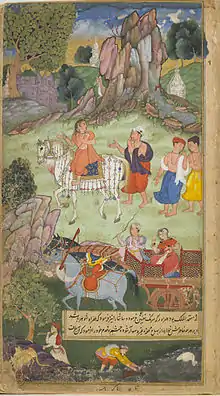Shanta
Shanta is a character in the Rāmāyaṇa. She is the adoptive daughter of King Romapāda of Aṅga and wife of R̥śyaśr̥ṇga. In northern recensions of the Rāmāyaṇa and later Indian literature, she is regarded as a daughter of Daśaratha who is then adopted by Romapāda.[1]
| Shanta | |
|---|---|
 Rishyasringa travels to Ayodhya with Shanta | |
| Affiliation | Daughter of King Dasharatha |
| Personal information | |
| Parents | Dasharatha (father) Kaushalya (mother) Romapada (adoptive father) Vershini (adoptive mother) Sumitra (step-mother) Kaikeyi (step-mother) |
| Siblings | Rama (brother) Lakshmana, Bharata and Shatrughna (half-brothers) |
| Spouse | Rishyasringa |
Legend
Shanta was educated in the Vedas, arts, craft as well as in warfare, and was considered to have been very beautiful. One day, while her father, the king Romapada, was busy in conversation with Shanta, a brahmin came to ask for help in cultivation in the days of the monsoon. Romapada did not pay attention to the brahmin's plight. This irritated and enraged the brahmin, who left the kingdom. Indra, the god of rain, was unable to bear the insult to his devotee, so there was little rainfall during the monsoon season resulting in drought in the kingdom. Meanwhile, Dasharatha wanted a son to continue his legacy and enrich his royal dynasty. It was advised that the troubles of both kingdoms could only be alleviated by yajnas performed by a brahmin with powers that come from the observance of perfect chastity and that the only such person was Rishyasringa.[2]
Rishyasringa had been raised by Vibhandaka, isolated from society without knowledge of women. He had to be brought to the city and be persuaded to carry out the necessary yajna ceremonies. Despite their fear of the power and anger of Vibhandaka, both kings send young women to introduce the boy to the normal society, then Shanta fulfils this task and Rishyasringa marries Shanta, he then agrees to perform yajna for Anga, during the recitation of it, it rained heavily, the public rejoiced and there were festivals in Anga.[2]
Rishyasringa also performed a Putra Kameshthi yajna for Dasharatha to beget progeny, and as the consequence of the said yajna Rama, Bharata, and the twins Lakshmana and Shatrughna were born.
References
- Goldman, Robert P. (1984). The Rāmāyaṇa of Vālmīki: An Epic of Ancient India. Vol. I: Bālakāṇḍa. Princeton University Press. p. 75.
The northern recensions of the epic, and much of later Indian literature, regard Śāntā as actually a daughter of Daśaratha given in adoption to his friend and ally Lomapāda (Romapāda). On the basis of careful textual analysis, Asoke Chatterjee has shown this tradition to be a later invention of the northern redactors, owing its existence to their confusion of the Añga monarch, Daśaratha or Lomapāda, mentioned in several purānic genealogies, with the Kosalan Daśaratha.
- Kanuga, G.B. (1993). The Immortal Love of Rama. New Delhi: Yuganter Press. pp. 48–49. ISBN 9781897829509.
.jpg.webp)
